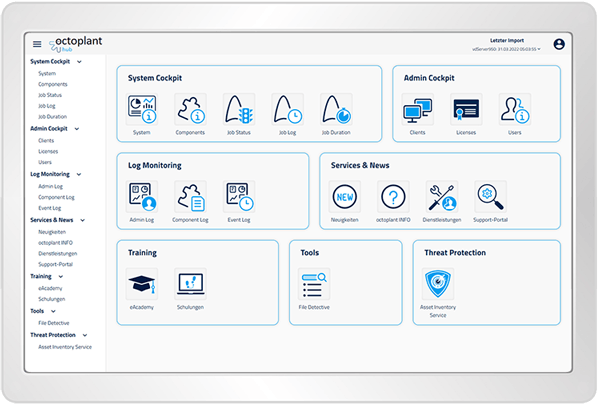
Embracing a cloud native future at AUVESY-MDT
Through its ‘octoplant’ product, AUVESY-MDT helps industrial plants to keep smart production machinery and devices running. By providing meaningful insights via business intelligence (BI), device management and data backups, octoplant enables factories to improve operational efficiency, reduce downtime and recover quickly from outages. With the power of BI, customers can make better and faster decisions on a sound data basis from their holistic production chain. AUVESY-MDT is already the market leader in this domain and wanted to provide even more value to its customers.
The BI features within octoplant were provided by ‘octoplant hub’ and this was an on-premises solution – a constraint that was impeding product innovation. Our client recognised that migrating octoplant hub to the cloud would unlock a range of new features for customers. By transforming the product into a multi-tenant software-as-a-service platform, AUVESY-MDT would be able to offer customers cloud data storage and processing, multi-plant data aggregation, and embedded BI tools.

This would be the company’s first significant step into the cloud, so AUVESY-MDT commissioned Scott Logic to ratify the planned cloud architecture, de-risk the cloud migration, and upskill the company’s in-house team.
Rapid discovery to scope the work
We assigned a small team of highly experienced consultants to the client, who applied Scott Logic’s proven approach to project discovery to define the scope of the work. The client had already embarked on some initial planning and design work. However, a significant amount of uncertainty remained and so the discovery focused on understanding the business problem, designing the solution architecture, delivering a proof of concept, and agreeing the delivery approach. From this, the team shaped a baseline backlog for the build phase.
It would be a complex build and while the discovery phase had resolved enough uncertainty to allow delivery to commence, several questions remained that could only be answered during the build phase. In this context, our consultants recommended the use of Monte Carlo estimation to provide probabilistic forecasts of project duration. These forecasts helped our client to manage stakeholder expectations and exercise project governance; they also reinforced confidence in the team as the accuracy of the estimates was borne out over time.
Laying firm foundations in the cloud
With the cloud assuming a central role in the client’s future business strategy, we knew AUVESY-MDT would need cloud architecture that was extensible, scalable and flexible enough to meet their emerging business requirements. Our lead consultant designed an architecture spanning a wide range of proprietary and open source technologies, ranging from Azure Container Apps, Azure AD B2C and Microsoft Power BI Embedded, through to Snowflake and dbt (Data Build Tool).
Given the client’s inexperience with cloud technologies and the comparatively small-scale cloud architecture, we recommended tools tailored to their needs. Significantly less complicated than Kubernetes, Azure Container Apps was the right-size tool for managing the client’s microservices; and built within it is Distributed Application Runtime (Dapr), an open source tool that provides APIs which simplify microservice connectivity. In future, Dapr will allow AUVESY-MDT to swap out microservices with ease.

A simple but powerful user interface
With users ranging from operatives on the factory floor to business leaders in the boardroom, octoplant hub needed to address a variety of user needs and proficiency levels. A significant proportion of users would access octoplant hub on a tablet device via a web app, so Power BI Embedded became the obvious software choice to enable users to access bespoke dashboards on the move. We supported the team to install and configure this software and to work around its constraints.
One such constraint was that custom data imports were not possible ‘out of the box’ with Power BI Embedded, and this was a key client requirement. With limited vendor capability to address this challenge, our team designed a bespoke solution for AUVESY-MDT, making use of TOM (Tabular Object Model), a Microsoft Power BI language for programmatically creating data models.
Knowledge transfer through close collaboration
A key objective of the project was knowledge transfer to upskill the client team rapidly. We recommended an embedded-team approach, with the team led by our lead consultant. While the collaboration would mostly be remote, a foundational factor in its success was early face-to-face engagement. Our consultants flew out to AUVESY-MDT’s headquarters in Germany for several days of discovery workshops, allowing the team to bond.
Our lead consultant planned the delivery programme such that each Scott Logic consultant worked in partnership with a client team member on a specific area. Rather than working on the same ticket which might have impeded progress, the pairs worked together on a given area – e.g. security – encouraging lots of discussion and knowledge sharing in the process of planning the right approach. Despite their inexperience with cloud technologies, the client team proved to be apt pupils which allowed knowledge transfer to be achieved rapidly.
In addition, it allowed for a very smooth handover to the client team at the end of the project. With its versatile new cloud architecture and a highly effective, upskilled in-house team, AUVESY-MDT now has everything in place to ensure that octoplant hub keeps pace with its customers’ needs into the future.

At AUVESY-MDT, our customers are at the heart of everything we do and Scott Logic understood this from the start. On the journey to delivering this step-change in our customer offering, the Scott Logic team challenged us in all the right ways, resulting in some of the strongest technical delivery we have seen and the capacity for our team to take the product forward.
Stefan Jesse
Group Co-Chief Executive Officer

